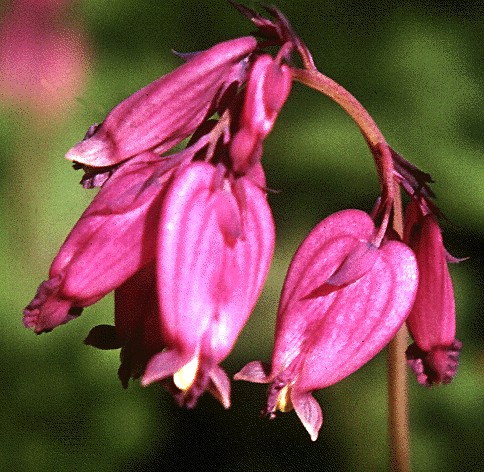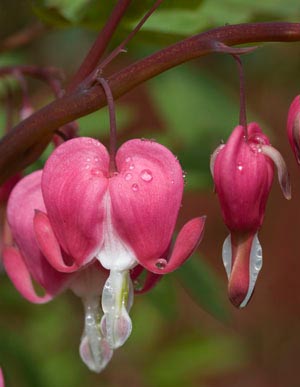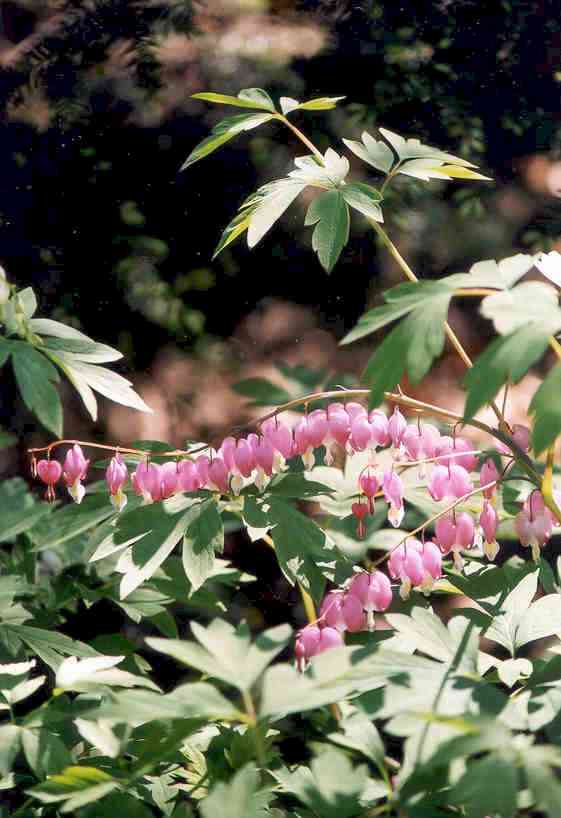Bleeding Heart
Family Name: Fumariaceae/ Papaveraceae
Latin Name: Dicentra formosa
Common Names: Pacific Bleeding Heart, Oregon Bleeding Heart and Western Bleeding Heart
Body System Affiliations: Central Nervous System
Botanical Description:
Habit: Herb-Perennial
Size: 12”-30”
Arrangement: Alternate
Leaves: Basal-Fern like, narrow and oblong blue-green leaves (1:313)
Flowers: 6-19 nodding (7) ¾ inch drooping pinkish-purple (1: 313), white, cherry and red heart-shaped flowers (4). The flowers are hermaphrodite (has both male and female organs) (5) and flowers from May to June.
Fruit: Pod-like capsules: several black, pebbled and shining appendages (1:313)
Underground Parts: Rhizomes or tuberous root are small and round. The tubers are tawny yellow-colored. (7)
Ecology:
Habitat: Woods and deep shady valleys (5), moist areas and streamside. “The plant prefers light (sandy) and medium (loamy) soils.” (5)
Range:
E. Asia - N. China, Japan, Korea and Siberia. Locally naturalized in Europe (5)
Cascades from southern B.C. south to California (1:313)
Native Where: If you can find it.
Ecological Relationships: If any discovered
Places/Dates Observed/Description:
Western (European-American) Uses/Relationships:
Medicine:
Part Used: Roots and Leaves (5:82)
Medicinal Actions: “Tonic, diuretic and alterative; useful in chronic cutaneous affections, syphilis and scrofula and in some menstrual complaints. The corydalin sold by druggists is often impure.” (7)
Indications: Remember those terms we’ve been discussing in class
Body System Associations: Central Nervous System
Constituents: Protopine, corydine, isocorydine, bulbocapnine, dicentrine and other isoquinoline alkaloids. (5:82)
Applications: Root and Herb tincture (5:82)
Preparation: Fresh Root Tincture, 1:2, 10 to 20 drops or applied topical; Dry Root Tincture, 1:5, 50% alcohol, 15 to 30 drops; Dry Herb Tincture, 1:5, 50% alcohol, 25-50 drops. (5:82)
Pharmacy: Up to three times a day when needed. (5:82)
Cautions: Not for use during pregnancy, for overt neuropathies or with prescription medications. It may induce a false positive in urine testing for opiates. (5)
Propagation:
Technique: “Bleeding Hearts are difficult to sprout from seed, so you're better off purchasing a potted plant and dividing it after it becomes well established and produces plenty of new growth. The roots are susceptible to breaking and should be handled with care when planting or moving. Prepare site in advance by working compost into soil. Plants do not like to be disturbed once planted.” (4) The “seeds (difficult) or division (early spring or fall). (4)
Seeds: The seeds should be sown in early spring, germinations
takes 1-6 months (4)
Harvest:
Plant Part/Season: Roots-summer and fall, foliage-summer after the seedpods have matured (5:82)
Method of Harvest: the seeds are difficult to harvest as it ripens and is shed very quickly (5)
Other Notes of Interest: The plant seems to be immune to rabbit and deer browsing (7)
Cautions: The plant is potentially poisonous and can also cause skin rashes (5).
Drawings, Photographs or Pressings [on separate pages]:
(NOTE: ONE ORIGINAL DRAWING IS REQUIRED)
Photographs, copies: Include name of photographer or original artist and source of image (as with drawings).

http://hcs.osu.edu/plantfacts/plant/record_detail.lasso ?-
?-
database=p_dictionary1&-table=itemlist&id=1090&-search

http://www.gardenmakers.com/dicentra_spectabilis.htm
References Cited:
- Mackinnon, Andy, and Jim Pojar. Plants of the Pacific Northwest Coast. Vancouver, British Columbia: Ministry of Forests and Lone Pine Publishing, 1994.
- Moerman, Daniel E. Native American Ethnobotany Database. Aug 1999. Online at < http://www.umd.umich.edu/cgi-bin/herb/> >Visited 3-9-2001.
3. Author Unknown. <http://www.thriftyfun.com/tf77879379.tip.html>
4. Author Unknown. <http://www.pfaf.org/database/plants.php?Dicentra+spectabilis>
5. Moore, Michael. Medicinal Plants of the Pacific Northwest. New Mexico, Santa Fe: Red Crane Books, Inc., 2001.
6. Author Unknown. <http://permaculture.info/cgi-bin/eden?search=Dicentra+spectabilis>
7. Author Unknown.<http://www.botanical.com/botanical/mgmh/t/turkey29.html>
Barry Lawrence
Arts, Environment and the Child
Winter 2006